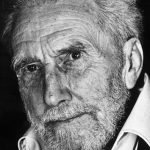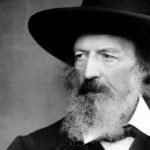Marke but this flea, and marke in this,
How little that which thou deny’st me is;
It suck’d me first, and now sucks thee,
And in this flea, out two bloods mingled bee;
Thou know’st that this cannot be said
A sinne, nor shame, nor loss of maidenhead,
Yet this enjoyes before it wooe,
And pamper’d swells with one blood made of two
And this, alas, is more than wee would doe.Oh, stay, three lives in one flea spare,
Where wee almost, yea more then maryed are.
This flea is you and I, and this
Our mariage bed, and mariage temple is;
Though parents grudge, and you, w’are met,
And cloistered in these living walls of Jet.
Though use make you apt to kill mee,
Let not to that, selfe murder added bee,
And sacrilege, three sinnes in killing three.Cruell and sodaine, hast thou since
Purpled thy naile, in blood of innocence?
Wherein could this flea guilty bee,
Except in that drop which is suckd from thee?
Yet thou triumph’st, and saist that thou
Find’st not thy selfe, nor mee the weaker now;
‘Tis true, then learne how false, fears bee;
Just so much honor, when thou yeeld’st to mee,
Will wast, as this flea’s death tooke life from thee.
John Donne left an incredibly rich heritage. It concerns both the quantity of his works and their quality, and “The Flea” is an excellent example of it. Here, one can clearly see why the intricate structure of Donne’s poems is often compared to lace.
Most poets who lived and worked at the same time as John Donne used so-called linear structure, in which the central image goes through the stages of introduction, exploration, and decline. John Donne, by contrast, chooses a single metaphor as a center of a poem and “weaves” several sets of associations around it. As a result of this, the whole poem is built around a single image, which is the essence of the metaphor. The conclusion that finishes the “lace” can be quite paradoxical, and this is the case with “The Flea”.
The first stanza of “The Flea” is a classical introduction of an image. Yet, in the second stanza the development of the metaphor takes an unexpected turn, and thus the metaphor seems to be exhausted (at first glance, at least). The third stanza brings back the initial metaphor, but it is not identical: the image is enriched with the suicidal motives, so typical to Donne’s works. Here, a murder or a suicide naturally stems from the discussion of moral taboos. The next stanza brings us back to the initial metaphor once again, and once again it shows the topic from a new, completely different, angle.
“The Flea” poem is just another example of the tendency to turn a metaphor “upside down”, which is so typical of John Donne. The image of a flea, hardly attractive in itself, is suggested as a symbol of an intimate contact between lovers, while in real life such a contact is restricted by moral norms. When a flea bites both the lovers, their blood melts in it, and as a result of this a type of intimate connection between the two people is established. This comparison must have looked really bizarre at the time of John Donne, and it still seems weird nowadays.
One more important feature of this poem (and of Donne’s works, in general) is the poet’s ability to introduce several explanations for one image, each of them having different depth. A flea becomes a symbol of hopeless love, sexual contact as a mix of blood (at least in a flea’s belly), a murder and a suicide, and a dozen of other, more or less obvious, things. Thus, the author demonstrates a variety of meanings hidden in each object around us.
The Russian poet Iosif Brodsky, who translated a lot of John Donne’s works, described his poetry as an attempt to translate the sacral truth of the universe into the language of ordinary human beings, the language of his reader.
Princes do but play us; compared to this,
All honor’s mimic, all wealth alchemy.
This stanza brings us back to the alchemy, to the wealth of the alchemical – or can we already mention chemical? – world, humans being its center. And to this very center the last stanza is devoted.
Shine here to us, and thou art everywhere;
This bed thy center is, these walls thy sphere.
A human being as the essence of the universe. Love as the most valuable treasure that a person can possess in all his short life.
Reviewed by Katerina Sidoruk



